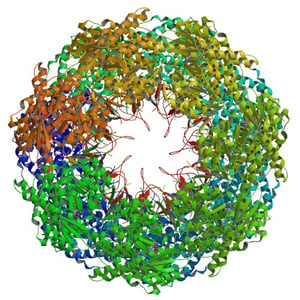 Proteins that form complexes tend to form aggregates during recombinant expression. So the best method is to co-express proteins with suitable partner protein. Chaperones are one of those proteins that help insoluble protein formation. Researchers observed the enhanced solubility of some proteins when co-expressed with chaperones. However, the choice of suitable chaperone for a particular protein is difficult to assume and only with trial and error methods one can achieve a soluble protein. Chaperones act as catalysts that prevent aggregation of nascent chains and unfolding aggregate proteins. Co-expression of recombinant proteins with chaperones help in improved solubility, enhanced specific activity and yield of target proteins.
Proteins that form complexes tend to form aggregates during recombinant expression. So the best method is to co-express proteins with suitable partner protein. Chaperones are one of those proteins that help insoluble protein formation. Researchers observed the enhanced solubility of some proteins when co-expressed with chaperones. However, the choice of suitable chaperone for a particular protein is difficult to assume and only with trial and error methods one can achieve a soluble protein. Chaperones act as catalysts that prevent aggregation of nascent chains and unfolding aggregate proteins. Co-expression of recombinant proteins with chaperones help in improved solubility, enhanced specific activity and yield of target proteins.
LIST OF CHAPERONES
PDI- Protein disulfide Isomerase is an enzyme that acts as both isomerase and a chaperone. It helps in folding and assembly of polypeptide chain during protein maturation and disulfide bond formation.
GroEL/GroES- GroEL and its co-chaperonin GroES work together for proper folding of proteins. Non-native proteins are first attached to hydrophobic amino acids of GroEL and then passed into the cavity with the aid of trigger from ATP and GroES and with the cavity of GroEL, ATP is hydrolyzed and properly folded protein is released to the outside.
DnaKJE- DnaK, DnaJ, GrpE chaperones together form DnaKJE system, which works together with ClpB, a heat shock protein to solubilize protein aggregates and refold them into active proteins.
TF- Trigger factor is the first chaperone that binds to the nascent polypeptide chain. TF keeps the newly synthesized protein in the open conformation and prevents it from aggregation. Trigger factor also has Peptidyl-Prolyl cis/trans isomerase (PPlase) activity.
Skp- In E.coli, periplasmic seventeen kilodalton protein (Skp) act as chaperone and helps in proper protein folding in bacterial periplasm. Co-expression of proteins with skp helps in proper folding of recombinant proteins. Skp is also used in co-expression of virulence factors.
FkpA- Co-expression increased ten times the productivity of scFv fragment with FkpA. It is a periplasmic protein that prevents the aggregate formation of bacterial envelope proteins. Apart from chaperone activity, it also has PPlase activity.
VanX- This is a lysis partner used to release the desired protein into the media avoiding intracellular aggregate formation.
Other effects of Chaperone Co-expression on recombinant proteins
Although Chaperone co-expression is beneficial for recombinant protein production in enhancing proper protein folding, there are some undesirable effects in some cases such as a decrease in protein yield and quality. Overexpression of chaperone alone is toxic to cells hence co-chaperones are expressed together with chaperones. Under certain conditions, chaperones show contrasting properties, chaperones like DnaK act as both folding modulator and also as the proteolytic enhancer. In addition, overexpression of DnaK results in down-regulation of heat shock proteins. Cell growth retardation is one of the main problems faced with chaperone co-expression due to toxicity of chaperones.
GroELS system is used when the target protein is 10-60 kDa. Larger proteins are unable to be processed by the system as they can not pass through the GroEL cavity. GroEL chaperone system also promotes protein degradation of regulatory proteins. In some cases instead of aiding in refolding of protein aggregates, the GroEL system helps in the degradation of protein aggregates. Bacterial chaperones are functional not only in a bacterial expression system but also in the Insect and mammalian expression system. It is to be noted that these chaperone systems in insect cell expression system and mammalian cell expression system does not enhance proteolytic activity.
References:
- Kamna Jhamb, Debendra K. Sahoo, Production of soluble recombinant proteins in Escherichia coli: Effects of process conditions and chaperone co-expression on cell growth and production of xylanase, Bioresource Technology, Volume 123, 2012, Pages 135-143.
- Bothmann H., Plückthun A. (2001) Improving Expression of scFv Fragments by Coexpression of Periplasmic Chaperones. In: Kontermann R., Dübel (eds) Antibody Engineering. Springer Lab Manuals. Springer, Berlin, Heidelberg.






